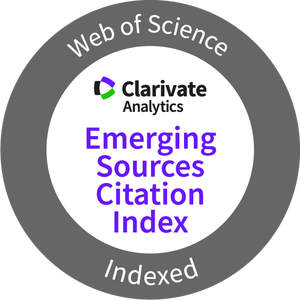Body perception and quality of life in ex-volleyball players in Jaén
Abstract
The study analysed the relationship between body image and quality of life of participants in federated volleyball competitions in Jaén. A descriptive and cross-sectional research was carried out, where athletes completed a questionnaire about their body image and quality of life. The captains and coaches completed self-completed surveys. A total of 199 subjects were studied, including 18 captains and 21 coaches. 43.6% of the women and 61.3% of the men considered themselves to have a good quality of life. Participants highlighted the importance of their personal experience in maintaining this lifestyle. In terms of body image perception, men perceived themselves better than women, with 46.9% of men choosing the options "good" or "very good", compared to 41% of women. A direct relationship was found between perceived quality of life and body image, supported by Pearson's chi-square test using SPSS software, with a value of p= 0,000. The study concludes that athletes, in general, have a high quality of life, with men perceiving it better than women. In addition, male athletes have a better perception of body image than female athletes.
Downloads
-
Abstract354
-
PDF (Español (España))220
References
Alonso, J. M. R., Bernal, C. B., Martínez, J. M. G., Escolar, P. M., & Romero, M. G. (2020). Importancia De La Práctica Deportiva En Edad Escolar: Validación Cuestinoario Cudaeem. / Importância Da Prática Esportiva Na Idade Escolar: Validação Do Questionário De Cudaeem. Brazilian Journal of Development, 6(4), 21598–21615. https://doi.org/10.34117/bjdv6n4-361
Amador-Muñoz, L., & Esteban-Ibáñez, M. (2015). Calidad de vida y formación en hábitos saludables en la alimentación de personas mayores. Revista de Humanidades, 25, 145-168. https://doi.org/10.5944/rdh.25.2015.14374
Ardila, R. (2003). Calidad de vida: una definición integradora. Revista Latinoamericana de Psicología, 35(2), 161-164.
Ato, M., López, J. J., & Benavente, A. (2013). A classification system for research designs in psychology. [Sistema de clasificación de los diseños de investigación en psicología]. Anales de Psicología, 29(3), 1038-1059. https://doi.org/10.6018/analesps.29.3.178511
Barbado, C., & Martínez-Moreno, A. (2021). Trabajadores de centros deportivos fitness percepción de liderazgo, engagement y estrés. Revista Internacional de Medicina y Ciencias de la Actividad Física el Deporte, 22(85), 1-17. https://doi.org/10.15366/rimcafd2022.85.001
Batista, M., Folgado dos Santos, J. M., Honório, S., Rocha, J., Serrano, J., & Petrica, J. M. (2021). Lifestyles and satisfaction with life of veteran athletes a prospective test based on the theory of self-determination. [Estilos de vida y satisfacción con la vida de los deportistas veteranos una prueba prospectiva basada en la teoría de la autodeterminación]. Retos. Nuevas tendencias en Educación Física, Deporte y Recreación, 39, 998-1000.
Caracuel-Cáliz, R. F. (2016). Influencia de la educación física en los hábitos saludables del alumnado de primer ciclo de educación secundaria en centros de las comarcas del sur de Córdoba [Tesis Doctoral, Universidad de Granada, Repositorio de la Universidad de Granada]. http://hdl.handle.net/10481/45389
Carrasco, J., & Calderero, J. (2000). Aprendo a investigar en educación. Madrid: Rialp.
Collado-Fernández, D. (2005). Transmisión y adquisición de valores a través de un programa de Educación Física basado en el juego motor, en un grupo de alumnos y alumnas de Primero de la ESO. [Tesis Doctoral, Universidad de Granada]. Repositorio de la Universidad de Granada: http://hdl.handle.net/10481/669
Corrales-Salguero, A. R. (2009). Hábitos saludables de la población relacionados con la actividad física como ocio. Trances, 1(2), 80-91.
Cortés, R. G., Alejo, S. J., Moreno, N. E., & Valle M. O. (2015). El perfil de salud de Nottingham (nph), excelente indicador en la valoración integral del adulto mayor. Waxapa, 7(12), 36-40.
Fernández, B., Herrera, S., & Valenzuela, E. (2014). Tercera encuesta nacional Calidad de Vida en la Vejez. Santiago de Chile: Pontificia Universidad Católica de Chile.
Flavia-Vivaldi, E. V. (2012). Bienestar Psicológico, Apoyo Social Percibido y Percepción de Salud en Adultos Mayores. Terapia Psicológica, 30(2), 23-29. https://doi.org/10.4067/S0718-48082012000200002
Fuentes-Justicia, E. (2011). Adquisición y mantenimiento de hábitos de vida saludables en los escolares de primer ciclo de Educación Secundaria Obligatoria de Jerez de la Frontera (Cádiz). [Tesis Doctoral, Universidad de Granada]. Repositorio de la Universidad de Granada: http://hdl.handle.net/10481/19435
Gallardo-Peralta, L., Córdova Jorquera, I., Piña Morán, M., & Urrutia-Quiroz, B. (2018). Diferencias de género en salud y calidad de vida en personas mayores del norte de Chile. Revista Latinoamericana, 49, 1-23. https://doi.org/10.4067/S0718-65682018000100153
García-Viniegras, V. (2008). Calidad de Vida. Aspectos teóricos y metodológicos. Editorial Paidós.
Guzmán, R., Saucedo, T., García, M., Galván, M., & Del Castillo, A. (2017). Imagen corporal e índice de masa corporal en mujeres indígenas del Estado de Hidalgo. Revista Mexicana de Trastornos Alimentarios, 8(1), 56-62. https://doi.org/10.1016/j.rmta.2017.01.002
Jiménez Boraita, R., Arriscado Alsina, D., Dalmau Torres, J. M., & Gargallo Ibort, E. (2021). Determinantes de la satisfacción corporal en adolescentes de La Rioja. Revista Española de Salud Pública, 95, 1-12.
Latorre, A., Del Rincón, D., & Arnal, J. (1996; 2003). Bases metodológicas de la investigación educativa. Hurtado Ediciones.
López Vázquez, A. (2021). Relación entre calidad de vida relacionada con la salud y la percepción de la imagen corporal en pacientes con síndrome metabólico adscritos a la UMF [Tesis Doctoral en Universidad Autónoma de San Luis Potosí. Repositorio nacional CONACYT]. https://repositorioinstitucional.uaslp.mx/xmlui/handle/i/7677
López-Rincón, F. J., Morales-Jiménez, A., Ugarte-Esquivel, I., Rodríguez-Mejía, L., Hernández-Torres, J. L., & Sauza-Niño, LL. (2019). Comparación de la percepción de calidad de vida relacionada con la salud en hombres y mujeres adultos mayores. Enfermería Global, 18(1), 54-62. https://doi.org/10.6018/eglobal.18.2.331781
Love, A., Goldman, N., & Rodríguez, G. (2008). Is positive well-being protective of mobility limitations among older adults? [¿El bienestar positivo protege de las limitaciones de movilidad entre los adultos mayores?]. Journal of Gerontology, 63(6), 321-327. https://doi.org/10.1093/geronb/63.6.P321
Martín Sánchez, J. A., Caracuel Cáliz, R. F., Fernández, D. C., Torres Campos, B., & Cepero González, M. del M. (2023). Valoración de la imagen y la composición corporal tras la implementación de un programa de actividad física en alumnado de Educación Primaria. Retos, 47, 814–822. https://doi.org/10.47197/retos.v47.90727
Mejía-Rojas, M. E. (2012). Incertidumbre, calidad de vida e imagen corporal en mujeres sometidas a mastectomía. Departamento del Cuidado y Práctica de la Enfermería. https://repositorio.unal.edu.co/handle/unal/20864
Pedraza-Avilés, A. G., & Vázquez-Navarrete, I. (2010). Calidad de vida relacionada con la salud en adultos mayores de una clínica de medicina familiar. Revista Médica del Instituto Mexicano del Seguro Social, 48(5), 475-484.
Prieto, M. E., Fernández, G., Rojo, F., Lardiés, R., Rodríguez, V., & Ahmed, K. (2008). Factores sociodemográficos y de salud en el bienestar emocional como dominio de calidad de vida de las personas mayores en la Comunidad de Madrid: 2005. Revista Española de Salud Pública, 82(3), 301-313. https://doi.org/10.1590/S1135-57272008000300006
Reguant-Álvarez, M., & Torrado-Fonseca, M. (2016). El Método Delphi. REIRE, 9(1), 87-102.
Reynaga-Estrada, P., Arévalo, E. I., Verdesoto, Á. M., Jiménez, I. M., Preciado, M., & Morales, J. J. (2016). Beneficios psicológicos de la actividad física en el trabajo de un centro educativo. Retos. Nuevas Tendencias en Educación Física, Deportes y Recreación, 30(1), 203-206. https://doi.org/10.47197/retos.v0i30.50254
Rodríguez-Rodríguez, E., López-Plaza, B., López-Sobaler, A. M., & Ortega, R. M. (2011). Prevalencia de sobrepeso y obesidad en adultos españoles. Nutrición Hospitalaria, 26(2), 355-363.
Salaberria, K., Rodríguez, S., & Cruz, S. (2007). Percepción de la imagen corporal. Osasunaz, 8, 171-183.
Santos, S. L., Souza Junior T. P., & Oliveira, S. R. L. (2010). Artes marciais, esportes de combate ou jogos de oposição? [¿Artes marciales, deportes de combate o juegos de oposición?]. Lecturas: Educación Física y Deportes. Revista Digital - Buenos Aires, 148, 204-221.
Skinner, J., Edwards, A., & Smith, A. C. T. (2020). Qualitative research in sport management [Investigación cualitativa en gestión deportiva]. (2nd ed.). Routledge. https://doi.org/10.4324/9780367854249
Torres-Guerrero, J. (2019). Voleibol: un deporte para la sociedad del siglo XXI. Ponencia en: VI Jornadas de Clubes de voleibol de Andalucía. Federación Andaluza de Voleibol. Dirección Técnica.
Veal, A. J., & Darcy, S. (2014). Research methods in sport studies and sport management: a practical guide. Routledge. https://doi.org/10.4324/9781315776668
Vílchez-Barroso, G. (2007). Adquisición y mantenimiento de hábitos de vida saludable en los escolares de Tercer Ciclo de Educación Primaria de la comarca granadina de los Montes Orientales y la influencia de la Educación Física sobre ellos [Tesis Doctoral, Universidad de Granada, Repositorio de la Universidad de Granada]. http://hdl.handle.net/10481/1561
Zaragoza, A., & Ortiz, R. (2012). Estado nutricional y nivel de actividad física según percepción de los estudiantes de la Universidad de Alicante. Revista Española de Nutrición Comunitaria, 18(3), 149-153.
The works and papers that are published in this Journal are subject to the following terms:
1. The Publication Service of the University of Murcia (the publisher) has the Publication Rights (Copyright) to the published papers and works, and favors and permits the reusing of the same under the license indicated in point 2.
© Servicio de Publicaciones, Universidad de Murcia, 2013
2. The papers and works are to be published in the digital edition of the Journal under the license Creative Commons Reconocimiento-No Comercial-Sin Obra Derivada 3.0 España (legal text). The copying, using, spreading, transmitting and publicly displaying of the papers, works or publication are permitted as long as: i) the authors and original sources (Journal, publisher and URL of the publication) are quoted; ii) it is not used for commercial benefit; iii) the existence and specifications of this users license are mentioned.
3. Conditions of Self-Archiving. It is permitted and encouraged that the authors spread electronically the pre-print (before printing) and/or post-print (the revised, evaluated and accepted) versions of their papers or works before their publication since this favors their circulation and early diffusion and therefore can help increase their citation and quotation, and also there reach through the academic community.
The works and papers that are published in this Journal are subject to the following terms:
1. The Publication Service of the University of Murcia (the publisher) has the Publication Rights (Copyright) to the published papers and works, and favors and permits the reusing of the same under the license indicated in point 2.
© Servicio de Publicaciones, Universidad de Murcia, 2013
2. The papers and works are to be published in the digital edition of the Journal under the license Creative Commons Reconocimiento-No Comercial-Sin Obra Derivada 3.0 España (legal text). The copying, using, spreading, transmitting and publicly displaying of the papers, works or publication are permitted as long as: i) the authors and original sources (Journal, publisher and URL of the publication) are quoted; ii) it is not used for commercial benefit; iii) the existence and specifications of this users license are mentioned.
3. Conditions of Self-Archiving. It is permitted and encouraged that the authors spread electronically the pre-print (before printing) and/or post-print (the revised, evaluated and accepted) versions of their papers or works before their publication since this favors their circulation and early diffusion and therefore can help increase their citation and quotation, and also there reach through the academic community.

















